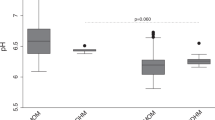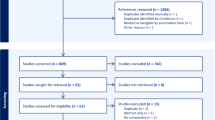Abstract
Objective:
To determine fatty acid levels in the US donor milk supply.
Study Design:
Donor human milk samples from Iowa (n=62), Texas (n=5), North Carolina (n=5) and California (n=5) were analyzed by gas chromatography. Levels in the Iowa donor milk were compared before and after pasteurization using Student's t-test. Docosahexaenoic acid (DHA) and arachidonic acid (ARA) levels were compared among all milk banks using analysis of variance.
Result:
ARA (0.4 pre, 0.4 post, P=0.18) and DHA (0.073 pre, 0.073 post, P=0.84) were not affected by pasteurization. DHA varied between banks (P<0.0001), whereas ARA did not (P=0.3). DHA levels from all banks were lower than published values for maternal milk and infant formula (P<0.0001).
Conclusion:
Pasteurization of breastmilk does not affect DHA or ARA levels. However, DHA content in US donor milk varies with bank location and may not meet the recommended provision for preterm infants.
This is a preview of subscription content, access via your institution
Access options
Subscribe to this journal
Receive 12 print issues and online access
$259.00 per year
only $21.58 per issue
Buy this article
- Purchase on Springer Link
- Instant access to full article PDF
Prices may be subject to local taxes which are calculated during checkout

Similar content being viewed by others
References
Carlson SE, Neuringer M . Polyunsaturated fatty acid status and neurodevelopment: a summary and critical analysis of the literature. Lipids 1999; 34 (2): 171–178.
Innis SM . Dietary (n-3) fatty acids and brain development. J Nutr 2007; 137 (4): 855–859.
Koletzko B, Lien E, Agostoni C, Bohles H, Campoy C, Cetin I et al. The roles of long-chain polyunsaturated fatty acids in pregnancy, lactation and infancy: review of current knowledge and consensus recommendations. J Perinat Med 2008; 36 (1): 5–14.
Agostoni C, Marangoni F, Stival G, Gatelli I, Pinto F, Rise P et al. Whole blood fatty acid composition differs in term versus mildly preterm infants: small versus matched appropriate for gestational age. Pediatr Res 2008; 64 (3): 298–302.
Krabbendam L, Bakker E, Hornstra G, van Os J . Relationship between DHA status at birth and child problem behaviour at 7 years of age. Prostaglandins Leukot Essent Fatty Acids 2007; 76 (1): 29–34.
Tyson JE, Saigal S . Outcomes for extremely low-birth-weight infants: disappointing news. JAMA 2005; 294 (3): 371–373.
Rogers LK, Valentine CJ, Pennell M, Velten M, Britt RD, Dingess K et al. Maternal DHA supplementation decreases lung inflammation in hyperoxia-exposed newborn mice. J Nutr 2011; 141 (2): 214–222.
Joss-Moore LA, Wang Y, Baack ML, Yao J, Norris AW, Yu X et al. IUGR decreases PPARgamma and SETD8 expression in neonatal rat lung and these effects are ameliorated by maternal DHA supplementation. Early Hum Dev 2010; 86 (12): 785–791.
Crawford MA, Golfetto I, Ghebremeskel K, Min Y, Moodley T, Poston L et al. The potential role for arachidonic and docosahexaenoic acids in protection against some central nervous system injuries in preterm infants. Lipids 2003; 38 (4): 303–315.
Pawlik D, Lauterbach R, Turyk E . Fish-oil fat emulsion supplementation may reduce the risk of severe retinopathy in VLBW infants. Pediatrics 2011; 127 ((2): 223–228.
SanGiovanni JP, Chew EY . The role of omega-3 long-chain polyunsaturated fatty acids in health and disease of the retina. Prog Retin Eye Res 2005; 24 (1): 87–138.
Reisbick S, Neuringer M, Gohl E, Wald R, Anderson GJ . Visual attention in infant monkeys: effects of dietary fatty acids and age. Dev Psychol 1997; 33 (3): 387–395.
Hanebutt FL, Demmelmair H, Schiessl B, Larque E, Koletzko B . Long-chain polyunsaturated fatty acid (LC-PUFA) transfer across the placenta. Clin Nutr 2008; 27 (5): 685–693.
Lapillonne A, Eleni dit Trolli S, Kermorvant-Duchemin E . Postnatal docosahexaenoic acid deficiency is an inevitable consequence of current recommendations and practice in preterm infants. Neonatology 2010; 98 (4): 397–403.
Carlson SE, Werkman SH . A randomized trial of visual attention of preterm infants fed docosahexaenoic acid until two months. Lipids 1996; 31 (1): 85–90.
Fewtrell MS, Abbott RA, Kennedy K, Singhal A, Morley R, Caine E et al. Randomized, double-blind trial of long-chain polyunsaturated fatty acid supplementation with fish oil and borage oil in preterm infants. J Pediatr 2004; 144 (4): 471–479.
Clandinin MT, Van Aerde JE, Merkel KL, Harris CL, Springer MA, Hansen JW et al. Growth and development of preterm infants fed infant formulas containing docosahexaenoic acid and arachidonic acid. J Pediatr 2005; 146 (4): 461–468.
Makrides M, Gibson RA, McPhee AJ, Collins CT, Davis PG, Doyle LW et al. Neurodevelopmental outcomes of preterm infants fed high-dose docosahexaenoic acid: a randomized controlled trial. JAMA 2009; 301 (2): 175–182.
Henriksen C, Haugholt K, Lindgren M, Aurvag AK, Ronnestad A, Gronn M et al. Improved cognitive development among preterm infants attributable to early supplementation of human milk with docosahexaenoic acid and arachidonic acid. Pediatrics 2008; 121 (6): 1137–1145.
O’Connor DL, Hall R, Adamkin D, Auestad N, Castillo M, Connor WE et al. Growth and development in preterm infants fed long-chain polyunsaturated fatty acids: a prospective, randomized controlled trial. Pediatrics 2001; 108 (2): 359–371.
Heiman H, Schanler RJ . Benefits of maternal and donor human milk for premature infants. Early Hum Dev 2006; 82 (12): 781–787.
Quigley MA, Henderson G, Anthony MY, McGuire W . Formula milk versus donor breast milk for feeding preterm or low birth weight infants. Cochrane Database Syst Rev 2007; (4): CD002971.
Wight NE . Donor human milk for preterm infants. J Perinatol 2001; 21 (4): 249–254.
Guidelines Committe H. Guidelines for the Establishment and Operation of a Donor Human Milk Bank. J Hum Lact 2010; 24 (1): 49–52.
Lepage . Improved recovery of fatty acid through direct transesterification without prior extraction or purification. J Lipid Res 1984; 25: 1391–1396.
Kris-Etherton PM, Innis S . Position of the American Dietetic Association and Dietitians of Canada: dietary fatty acids. J Am Diet Assoc 2007; 107 (9): 1599–1611.
Lapillonne A, Jensen CL . Reevaluation of the DHA requirement for the premature infant. Prostaglandins Leukot Essent Fatty Acids 2009; 81 (2–3): 143–150.
Henderson TR, Fay TN, Hamosh M . Effect of pasteurization on long chain polyunsaturated fatty acid levels and enzyme activities of human milk. J Pediatr 1998; 132 (5): 876–878.
Fidler N, Sauerwald TU, Demmelmair H, Koletzko B . Fat content and fatty acid composition of fresh, pasteurized, or sterilized human milk. Adv Exp Med Biol 2001; 501: 485–495.
Valentine CJ, Morrow G, Fernandez S, Gulati P, Bartholomew D, Long D et al. Docosahexaenoic acid and amino acid contents in pasteurized donor milk are low for preterm infants. J Pediatr 2010; 157 (6): 906–910.
Koletzko B, Cetin I, Brenna JT . Dietary fat intakes for pregnant and lactating women. Br J Nutr 2007; 98 (5): 873–877.
Brenna JT, Varamini B, Jensen RG, Diersen-Schade DA, Boettcher JA, Arterburn LM . Docosahexaenoic and arachidonic acid concentrations in human breast milk worldwide. Am J Clin Nutr 2007; 85 (6): 1457–1464.
Smit EN, Muskiet FA, Boersma ER . Docosahexaenoic acid (DHA) status of breastfed malnourished infants and their mothers in North Pakistan. Adv Exp Med Biol 2000; 478: 395–396.
Koletzko B, Larque E, Demmelmair H . Placental transfer of long-chain polyunsaturated fatty acids (LC-PUFA). J Perinat Med 2007; 35 (Suppl 1): S5–11.
Koletzko B, Sauerwald U, Keicher U, Saule H, Wawatschek S, Bohles H et al. Fatty acid profiles, antioxidant status, and growth of preterm infants fed diets without or with long-chain polyunsaturated fatty acids. A randomized clinical trial. Eur J Nutr 2003; 42 (5): 243–253.
Agostoni C, Marangoni F, Bernardo L, Lammardo AM, Galli C, Riva E . Long-chain polyunsaturated fatty acids in human milk. Acta Paediatr Suppl 1999; 88 (430): 68–71.
Heiman H, Schanler RJ . Enteral nutrition for premature infants: the role of human milk. Semin Fetal Neonatal Med 2007; 12 (1): 26–34.
Acknowledgements
We are grateful to Dr Arthur Spector for his assistance in fatty acid analysis and Dr Patrick Brophy for the use of his laboratory space. Special thanks is extended to Jean Drulis and all the mothers who allowed the study of their milk from The Mother's Milk Bank of Iowa, The Mother's Milk Bank at Austin, WakeMed Mother's Milk Bank and The Mother's Milk Bank in San Jose, California. Financial support for this study was generously provided by the NICHD-K23HD057232 and NIDDK-R01DK081548.
Author information
Authors and Affiliations
Corresponding author
Ethics declarations
Competing interests
The authors declare no conflict of interest.
Rights and permissions
About this article
Cite this article
Baack, M., Norris, A., Yao, J. et al. Long-chain polyunsaturated fatty acid levels in US donor human milk: meeting the needs of premature infants?. J Perinatol 32, 598–603 (2012). https://doi.org/10.1038/jp.2011.152
Received:
Revised:
Accepted:
Published:
Issue Date:
DOI: https://doi.org/10.1038/jp.2011.152
Keywords
This article is cited by
-
Docosahexaenoic acid and the preterm infant
Maternal Health, Neonatology and Perinatology (2017)
-
Choline and polyunsaturated fatty acids in preterm infants’ maternal milk
European Journal of Nutrition (2017)
-
Breast milk DHA levels may increase after informing women: a community-based cohort study from South Dakota USA
International Breastfeeding Journal (2016)
-
Analysis of breast milk fatty acid composition using dried milk samples
International Breastfeeding Journal (2016)
-
Beyond building better brains: bridging the docosahexaenoic acid (DHA) gap of prematurity
Journal of Perinatology (2015)



